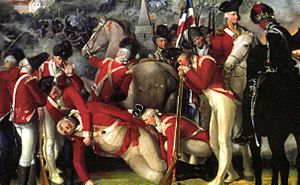Battle of Ballynahinch facts for kids
Quick facts for kids Battle of Ballynahinch |
|||||||
|---|---|---|---|---|---|---|---|
| Part of the Irish Rebellion of 1798 | |||||||
 A painting of the battle |
|||||||
|
|||||||
| Belligerents | |||||||
| Commanders and leaders | |||||||
| Strength | |||||||
| ~2,000 | ~4,000 | ||||||
| Casualties and losses | |||||||
| 3 killed ~30 wounded |
100-500 killed | ||||||
The Battle of Ballynahinch was an important fight during the Irish Rebellion of 1798. It happened between about 4,000 United Irishmen rebels and around 2,000 government soldiers. The rebels were led by Henry Munro, and the government troops were commanded by George Nugent.
The rebels first took over Newtownards on June 9th. The next day, they gathered and chose Munro as their leader. On June 11th, they moved into Ballynahinch. General Nugent led his government troops to Ballynahinch on June 12th. They took back the town and attacked the rebel positions. The rebels fought back on June 13th, but they were defeated.
Contents
What Led to the Battle?
The Irish Rebellion of 1798
The Irish Rebellion of 1798 was a big uprising in Ireland. It was started by a group called the Society of United Irishmen. They wanted more rights and changes in how Ireland was governed. In County Down, the rebellion had slowed down. This was because one of their leaders, William Steel Dickson, was arrested.
Rebels Regroup
Even with the setback, some rebel leaders kept the fight going. A rebel group led by David Bailie Warden attacked Newtownards on June 9th. Government soldiers there tried to stop them but had to leave. This allowed the rebels to set up their own temporary government in the town. On the same day, rebels also managed to capture Saintfield.
Government Response
In response, the British commander, George Nugent, pulled most of his soldiers from other areas. This allowed the rebels to gather in the middle of the county. About 4,000 rebels from Newtownards, Saintfield, and Ballynahinch came together on June 10th. They even had cannons they had taken from Bangor harbour.
Choosing a Leader
On June 11th, the rebels chose Henry Munro to be their commander. Munro was a linen merchant from Lisburn. He ordered his forces to take over Ballynahinch. They then set up their main camp at Montalto, a large estate nearby.
The Battle Begins
Nugent's Advance
On the morning of June 12th, General Nugent marched with about 2,000 government soldiers. These soldiers included groups like the Monaghan Militia and the Fifeshire Fencibles. They also had six cannons and two howitzers. They first went to Saintfield, but no rebels were there.
Taking Ballynahinch
Nugent's troops then moved towards Ballynahinch. More soldiers joined them, including the Argyll Fencibles. They captured a rebel outpost and then took control of the town. As night fell, Nugent's cannons began to fire at the rebel camp at Montalto and a nearby hill. Many rebels became scared by the attack and left their positions in the dark.
Rebel Attack at Dawn
Munro decided that the rebels would attack Ballynahinch at dawn. When the sun came up, Munro's rebels charged into the town. They pushed back some of the government soldiers in fierce street fighting. The rebels even managed to capture some cannons.
The Turning Point
However, the government troops used bugle calls to signal their retreat. The attacking rebels misunderstood these calls. They thought the bugles meant that more government soldiers were arriving. This made the rebels hesitate and start to lose courage. Seeing this, Nugent's officers ordered a counter-attack.
Rebel Defeat
The counter-attack caused many rebels to run away from Ballynahinch in all directions. Government cavalry, like dragoons and yeomanry, chased after them. Many rebels were killed or captured during this chase. One of the rebels killed was a camp follower named Betsy Gray.
After the Battle
Casualties and Consequences
General Nugent reported that his troops had killed 500 rebels. However, people living nearby said that only about 100 rebels had died. On the government side, only 3 soldiers were killed and about 30 were wounded.
The battle had harsh consequences for the rebels. Henry Munro was captured and executed by hanging on June 16th. Many other rebel prisoners also faced the same fate. After the battle, people who had left Ballynahinch when the rebels took over began to return. They wore white headbands and called themselves the "Supplementary Yeomanry." These people also looted the damaged town.

